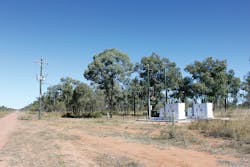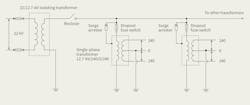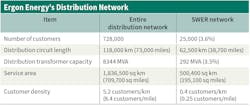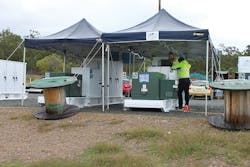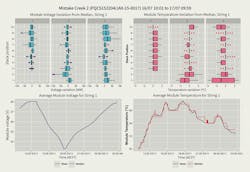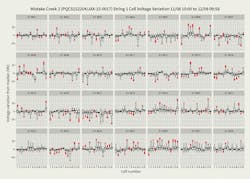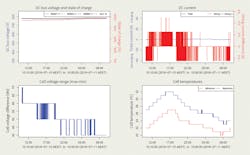Ergon Energy recently rolled out 2 MWh of lithium-ion battery storage across 13 sites in Queensland, Australia. It is extending the life of its vital single-wire earth return (SWER) system to customers in rural and remote Queensland using cutting-edge energy storage technology, which is a win-win for the utility and SWER customers.
Ergon Energy is responsible for electricity distribution to 97% of Queensland, one of Australia’s largest states in terms of area. With 20 grid utility support system (GUSS) units, voltage and capacity support are provided to rural and remote SWER distribution networks. Ergon Energy’s SWER networks were significantly extended during the 1970s, 1980s and 1990s to supply rural and remote customers. The low customer density required a low-cost network, achieved by the SWER construction.
SWER uses a single wire for power transmittal and the mass of earth as the current return path. Ergon Energy’s network design uses an isolation transformer, supplied from two phases of the distribution network, that provides a 19.1-kV or 12.7-kV high-voltage single-phase source. A single-phase step-down transformer is installed for each low-voltage customer who is supplied at 240 V.
When the SWER network was first constructed, the energy usage per customer was low, mostly attributable to household appliances such as lighting, radios, refrigerators and televisions. Over time, the demand for energy has increased, with customers installing air conditioners, cold rooms and pumps.
Since construction, most of Ergon Energy’s SWER network has remained relatively unchanged. As a result, many of these networks now have capacity and voltage constraints arising from the increased demand and electronic equipment now in use that is more sensitive to voltage variations. The SWER network needed to be augmented to continue to meet customer expectations.
SWER Networks
Ergon Energy has one of the largest SWER networks in the world and is a vital service to Queensland. On an average 300-km (186-mile) line, a typical SWER would have a 200-kVA isolator — supplying about 80 customers and possibly incorporating a regulator — and three or four 25-kVAR reactors. Augmentation is often undertaken by upgrading conductors on the SWER, but with an average of one customer per 2.5 km (1.6 miles), this augmentation is an expensive solution.
Voltage regulation on SWER feeders is challenging because of load variations significantly affecting the voltage. As load increases, the voltage reduces. And as the load decreases, the voltage increases with the additional factor of the Ferranti effect, which causes capacitive charging currents at extremely light loads, further increasing the supply voltage.
Because of its construction, the SWER network is inherently resistive with a resistance/reactance (R/X) ratio of 5 to 10, compared with an urban network where the R/X is less than 1. To overcome these challenges, an active device that can compensate for high and low operating voltages was designed, which — together with the current state-of-the-art inverters and energy storage — proved to be successful. Injection of real power into the network significantly improves the voltage (1 kW ≈ 1 V at 240 V) because of the highly resistive nature of the SWER feeders, and it assists with reducing load on the isolation transformer.
Intelligent Energy Storage
The GUSS units encompass an intelligent energy storage system consisting of the following components mounted on a transportable skid:
• Inverter power conversion system
• Energy storage system (lithium-ion batteries)
• Control, metering and communications.
GUSS units are specifically designed to manage voltage and capacity constraints for SWER lines. A GUSS unit is connected to the SWER feeder by a standard transformer used for customer connections and operates at low voltage (240-V line-neutral). Each unit is specified to withstand Australia’s harsh outback conditions.
The following specifications were developed to ensure the GUSS units would satisfy Ergon Energy’s requirements and operate reliably in the Queensland environment:
• Solar irradiance of 1000 W/sq m (93 W/sq ft)
• Inverter rating of 25 kVA
• Four quadrant inverter with low harmonic output
• Usable energy storage of 100 kWh
• Control system optimized for SWER with autonomous operation
• Temperature of 0°C to 45°C (32°F to 113°F)
• Packaged to enable servicing in the field and transport on harsh roads.
A sophisticated control algorithm developed by Ergon Energy regulates the export and import of both real and reactive power to keep the SWER voltage at the GUSS unit within control limits. The algorithm manages the state of charge of the battery and can take inputs from centralized control systems to better manage overall SWER line loading. Control is autonomous and not impacted by any failure of the communications or supervisory control and data acquisition (SCADA) equipment.
Reactive power is used to boost voltage in the initial instance, with real power injected when more voltage movement is required. When SWER voltages are high, the first response is to recharge the batteries by absorbing real power. If further reduction of the line voltage is required, reactive power is absorbed once the desired state of charge is reached.
GUSS Deployment
Following eight years of development and three trial units from Magellan Power, Ergon Energy realized the potential of energy storage and approved a project to procure and install 20 GUSS units as a low-cost alternative to traditional feeder augmentation. The S&C Electric Co. was awarded a contract to manufacture the GUSS units to the utility’s specifications.
Suitable SWER feeders were identified based on network need, historical data, local knowledge and power system modeling, which posed numerous challenges because of the asymmetrical single-phase nature of both loads and faults. The utility selected 13 suitable sites for the initial installation phase. These sites required a mix of 25-kVA (single GUSS) and 50-kVA (twin GUSS) installations, including feeders that needed two GUSS units to operate in parallel but at separate locations to address the network constraints.
The optimum siting for a GUSS unit is toward the end of the feeder, which presents a problem because of the vastness of outback Queensland in areas supplied by each feeder, which can have a circuit length in excess of 1000 km (621 miles). These remote locations mean sites can be some eight hours away from the nearest office when engineering support is required.
Many sections of Ergon Energy’s SWER network are only accessible by heavy vehicles in dry weather, and four-wheel-drive light vehicles and helicopters are the only means of access during the wet season. Communications services in these locations are also very limited, with cellular coverage unlikely and microwave/radio installation impractical because of the rugged and undulating terrain. Therefore, the only reliable form of communication for most of the sites is satellite. The utility had previously used Inmarsat BGAN M2M modems for network automation in remote areas, and this system was found to be suitable for GUSS.
Nontraditional Installation
As GUSS was a nontraditional solution to augment a feeder, it was decided that a nontraditional approach to the installation of field equipment would be investigated and implemented. Each business process associated with the deployment was examined to ensure it was essential and the outcome could not be achieved with a simpler or more-efficient method. Ergon Energy identified three critical processes that required a rethink:
• Centralized workshop testing and pre-commissioning was initiated to ensure all units were operational before being transported to the site. A remote management approach was used for testing of the final communications and software system to reset and clear faults on the units. Ergon Energy supplied communications and metering equipment installed in the workshop, where access to a full machine shop and spare parts was available. Hence, the only on-site work was the placement, connection and energization of the GUSS followed by final SCADA checks.
• Use of existing design and construction standards minimized site works and field crew training. GUSS connections were the same as for 25-kVA customer connections, including the earthing arrangements. On-site civil works were minimal, using precast concrete-slab footings enclosed with three-wire animal fencing. The four-wheel-drive fork-lift, which traveled on the delivery truck, was used to place the GUSS unit on the concrete slab. Five working days were required to complete and commission the GUSS unit from a bare site to a fully operational unit.
• Dual-mode satellite and 3G communications provided guaranteed communications. Previously, all field devices had to work on either 3G or satellite, but not both. Since the communications system had to work seamlessly with both modes, significant pre-configuration work was undertaken on both back-office systems and field network devices. This resulted in a system that enables any GUSS unit to operate on satellite or 3G with the same network addresses and host names presented to end users. The modems were installed in the workshop and no further on-site configuration was required. (If coverage from the 3G provider improves in the future, using the 3G cellular option instead of satellite would reduce data transmission costs.)
Communications and Control
The inverter, battery management system, statistical energy meter and embedded personal computer within the GUSS unit are all connected to a common router using a combination of Ethernet and serial connections. Each device is individually addressable and can communicate locally (for local data processing) and to Ergon Energy’s central servers.
Control of GUSS was planned with two distinct control paths. Operational control of the unit is through DNP3 using the distribution SCADA system, and engineering control is performed with vendor-supplied software. Abnormal operation of the units is reported by DNP3 using report-by-exception (RBE) alarming. RBE passes the alarm into an automatic event ticketing system, which, in turn, notifies the engineering support team. RBE was chosen for reporting as this reduces the traffic and hence expense on the satellite communications links. An additional benefit is that short-duration network events are captured that may have been missed with a polled approach.
Because of the remote location of the units, consideration also was given to how to work remotely with S&C to investigate any issues that arise. A combination of screen sharing and remote desktop tools enables S&C to view the status of units and assist with fault finding from its U.S. offices without the need for Ergon Energy staff to be on site.
Performance Monitoring
Management of the fleet of GUSS units has been set up to provide a rich set of information. As the supporting systems are developed, monitoring is critical to ensure that the units provide the expected benefits and operate for the lifetime expected. The capability of GUSS units to influence voltages on SWER networks makes monitoring critical while the settings for each system installed are fine tuned. The installation locations and temperature sensitivities of lithium-ion batteries resulted in the desire to install real-time monitoring of battery temperature to enable optimum lifetime performance.
Ergon Energy developed an automatic data collection and visualization system that provides practical and efficient management of the GUSS units. The performance of this system is measured by the ability to investigate and resolve faults within 30 hours, without the need to download data manually. In practice, the data collection system meets this requirement, with most events being reported to staff within five minutes and all data transferred to the utility’s servers within 25 hours.
The collection and processing of huge volumes of network performance and battery data can present a major problem. However, based on past experience, Ergon Energy opted to address this before any GUSS units were installed. Exploratory analysis of the data was performed on a regular basis on the major components (inverter and battery) to identify any emergent issues. Within two weeks, the graphs proved valuable by identifying a periodic disconnect/reconnect occurring with the battery system that lasted for five seconds. This fault, together with the data collected, was referred to and resolved by the equipment supplier.
Subsequently, as Ergon Energy’s engineers have become more familiar with operation of the GUSS units, more detailed performance graphs have been produced, including the voltage and temperature for each module of the 56-module battery. With the support of the battery vendor, the utility has developed software to interrogate the individual cells’ voltage from the battery management system every two minutes, with the aim of identifying outliers and potential issues before causing any operational problems.
Network Supported
The installation of the 100-kWh GUSS units on 13 sites was completed in August 2016, and the monitoring — using Ergon Energy’s control methodology — confirms the GUSS units are operating to support the network. The recorded daily voltage variation at the customers’ 240-V connections has been reduced significantly, by up to 40% in some instances.
Management and monitoring of the GUSS units is ongoing. The data collected creates a large energy storage system data set that provides a baseline for the evaluation of future performance. The systems, tools and work practices developed for the GUSS project are now available for other technology deployments and existing distribution network assets.
While energy storage has been around for many years, its use as a network support device on SWER is new. The continuing work Ergon Energy is doing in the performance management of GUSS units is industry leading and continues to inform asset management models for energy storage. The storage of such a large data set of high-resolution data from a fleet of GUSS units will provide an excellent data set for the future research and development of energy storage systems for Australian conditions.
As a result of employing intelligent energy storage systems, communications systems and performance management, Ergon Energy has been able to extend efficiently and effectively the life of an existing and vital electricity supply system to customers in rural and remote Queensland. The utility also has been an industry leader in the adoption of new technologies and development of the energy storage industry. ♦
Stephen Richardson is a technology innovation engineer at Ergon Energy. He has led the grid utility support system (GUSS) project from its development to implementation. He has 10 years of experience in the electricity industry testing and deploying cutting-edge storage technologies and renewable energy systems. He has a strong focus on how new technologies interact with the electricity network and how to support customers, particularly those who are rural and remote. Richardson is a registered professional engineer in Queensland, Australia.
David Ingram was formerly the principal engineer (technology innovation) at Ergon Energy. He has more than 15 years of experience in the electricity supply industry in a variety of generation, transmission and distribution roles. His focus is on the introduction of new technology into T&D networks. Ingram holds a Ph.D. degree in substation automation from the Queensland University of Technology, is a registered professional engineer in Queensland, Australia, and is a senior member of the IEEE.
About the Author
Stephen Richardson
Technology Innovation Engineer
Stephen Richardson is a technology innovation engineer at Ergon Energy. He has led the grid utility support system (GUSS) project from its development to implementation. He has 10 years of experience in the electricity industry testing and deploying cutting-edge storage technologies and renewable energy systems. He has a strong focus on how new technologies interact with the electricity network and how to support customers, particularly those who are rural and remote. Richardson is a registered professional engineer in Queensland, Australia.
David Ingram
David Ingram was formerly the principal engineer (technology innovation) at Ergon Energy. He has more than 15 years of experience in the electricity supply industry in a variety of generation, transmission and distribution roles. His focus is on the introduction of new technology into T&D networks. Ingram holds a Ph.D. degree in substation automation from the Queensland University of Technology, is a registered professional engineer in Queensland, Australia, and is a senior member of the IEEE.
